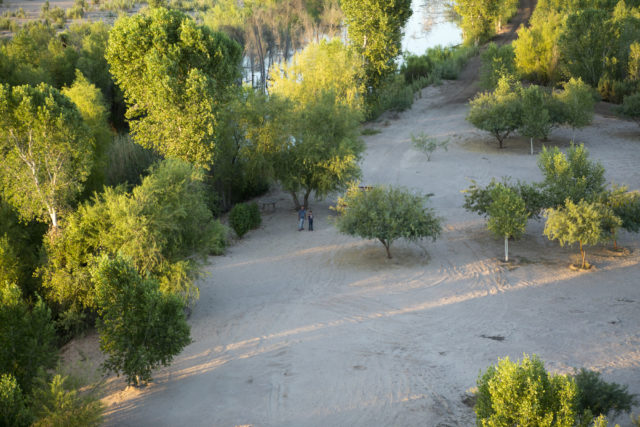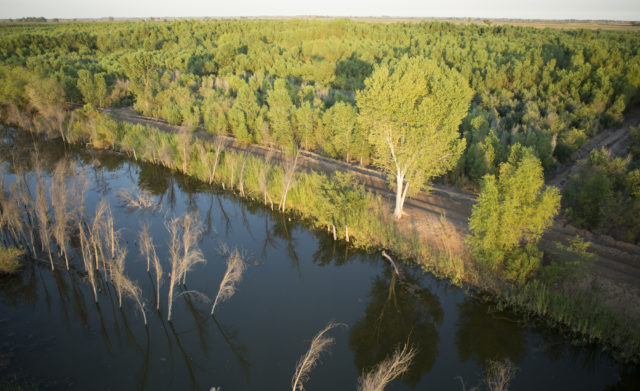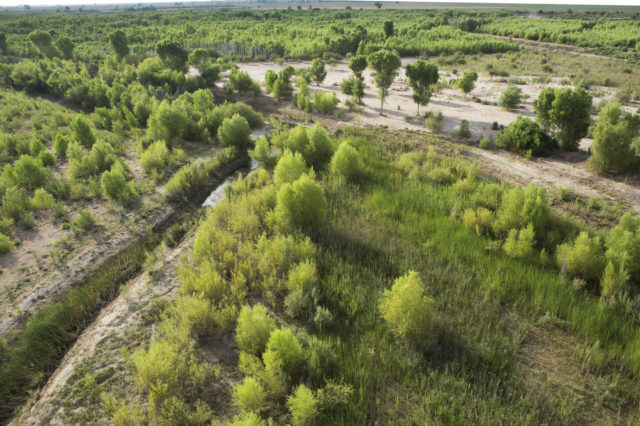Folks have been pretty excited at the Sonoran Institute offices recently as a new scientific report for the IBWC was released with interim results from the Minute 319 pulse flow. And while there have been a number of publications reporting on the findings, we thought we would take a few minutes to catch up those unfamiliar with this historic project.
We know that most readers aren’t fluent in water management lingo, like Minutes (what does this have to do with water?), treaties (what is the IBWC?), and flows (what is a pulse flow?), so we sat down with Karen Schlatter, Adaptive Management Specialist for the Colorado River Delta Program, to have her to answer some of your FAQ’s.
1. What was the original idea behind the pulse flow and why is it important for the Colorado Delta region?
The Colorado River “pulse flow” was a pilot flow delivery to the Colorado River Delta intended to mimic natural spring flood flows that historically occurred in the region. Water had not flowed the length of the river channel in the Delta since 1997, when heavy El Nino rains that year inundated the Colorado River Basin, so scientists were unsure as to what the ecological impacts of the flow would be or exactly how far the flows would travel down the river channel. But, we were optimistic that the flows would recover native habitat and improve the river’s hydrology and connectivity, at least temporarily. The pulse flow delivery amounts, locations, and timing were designed by a team of scientists with the goal of promoting germination of two key riparian tree species: cottonwood and willow. Cottonwood and willow trees are well adapted to dynamic rivers; big flood events actually provide the conditions that are required for natural germination.
From March 23 – May 18, 2014, approximately 105,400 acre-feet* of water surged through the Colorado River in Mexico, reconnecting habitats, wildlife, and human communities with the river for the first time in nearly 2 decades. The pulse flow was important not only for new native plants but also for birds, which were drawn to the flowing river in high numbers. Local communities also flocked to the river, and children got to see a river with water in it (and play in it!) for the first time in their lives. The river once again flowed from the U.S.-Mexican border all the way to the sea, reconnecting communities along the river in a celebration of water and life.
*One acre-foot of water is approximately the amount of water a family of five uses in one year.

2. At what stage in the process does this report represent? What are scientists seeing?
This is an interim report that documents impacts from the pulse flow the first two years following the release. It is the second report published by the Minute 319 Science Team; the first was published in December 2014, which documented results immediately following the flow release. A final report will be published in 2018, which will document longer-term impacts over course of the 5-year Minute 319 agreement (2013-2017).
Although the pulse flow was less than 1% of the river’s annual flow, the Minute 319 Science Team reported a number of significant ecological benefits from the release as well as lessons learned, which could be applied to future flow deliveries. The pulse flow inundated approximately 4,000 acres along the river’s length, which caused significant greening of vegetation in the floodplain as compared to previous years. It signified improved health and condition of existing plants as well as establishment of new plants following the release. In areas where the Sonoran Institute cleared non-native vegetation prior to the pulse flow release, we saw hundreds of cottonwood, willow, and other native plants germinate and take off after the flows receded. The flows also elevated groundwater levels along the corridor, which is critical for supporting riparian habitat. Bird diversity and abundance also increased after the flow release and continued to do so through 2015.

3. What are the IBWC and Minute 319? Why was this agreement historic?
The International Boundary and Water Commission (IBWC) and its Mexican counterpart (CILA) are U.S. and Mexican federal agencies that negotiate and implement binational water treaties and transboundary water allocations, including the treaty governing the Colorado River. Modifications of treaties are referred to as minutes.
In 2012, the IBWC and CILA successfully negotiated Minute 319 related to the Colorado River. Key components of the agreement include: 1) dedicated transboundary flows for environmental use in Mexico; 2) international projects including restoration, water conservation, and evaluation of new water sources; 3) storage of Mexican Colorado River water allocations in upstream US reservoirs; and 4) Mexico agreeing to share in future water shortages with the US. Minute 319 not only represents extraordinary binational collaboration amongst government agencies, conservation organizations, water users, and other Delta stakeholders, but it also recognizes the Delta as a global ecological treasure worth dedicating precious resources to. Minute 319 also is the first binational agreement in the world to dedicate flows for environmental purposes! It truly is a landmark agreement that is being used as a model for transboundary water management across the world.
4. What are the next steps and what are the future ramifications of this project?
The interim report was specifically developed to provide key results and lessons learned from the pulse flow to inform the next round of binational negotiations, which are currently ongoing. The binational negotiation team began discussions in the spring of 2016, and they hope to have the components in place for the next agreement by the end of this year. The goal, at least for the Sonoran Institute, is that the next minute builds upon the binational allocation of environmental flows to the Delta, and potentially extends the scope of restoration.
The Minute 319 Science Team will continue to monitor hydrology, vegetation, and wildlife through 2017, which is when the minute expires.
5. What does this project potentially mean for other ecological sites that might have similar water issues? (ie reduced flows due to climate change or over-usage of waterways?)
This project demonstrates that a relatively small amount of water, particularly when coupled with active restoration, can provide significant benefits to rivers with reduced flows. The flows created new habitat, increased bird diversity, and also provided a meaningful reconnection of local communities to the environment. When diverse stakeholders collaborate on Colorado River water management, governments, communities, and the environment have much to gain.

Blog Post By: Karen Schlatter, Sonoran Institute

Karen Schlatter is the Adaptive Management Specialist for the Colorado River Delta Program and has been working in the Delta Program since 2010. Karen manages the ecological monitoring program, guides adaptive management of restoration sites, and provides program support in communications and fundraising. She is a co-manager of the Minute 319 binational monitoring team and specializes in vegetation monitoring and riparian restoration ecology.
